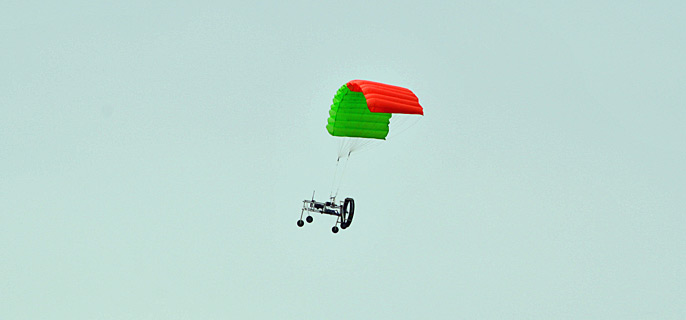
Just around 8:30 a.m. on a rainless, windless Wednesday, the go-ahead was given. An audience of perhaps 100 or so spectators watched with anticipation as a small aircraft, about the size of a large remote-controlled toy helicopter, took to the air and began circling a small potato field.
At an altitude of a couple hundred feet, the vehicle – equipped with a propeller and parachute to keep it aloft – made several passes over the field before coming to a smooth landing at just about the exact spot that it took off.

“This is all about precision agriculture,” said Dan Gadler, contract services engineer with Boeing Research & Technology. Precision agriculture uses high-resolution images taken from unmanned aircraft that can provide growers with valuable information they can use to increase crop yields while minimizing growing costs. The resolution from UAVs is measured in inches compared to several feet from fixed-wing aircraft or tens of feet from satellites. The higher the resolution, the more information for the grower. It means the grower can more precisely determine just how much water, pesticides and herbicides are needed for a specific area in the field.

It will be a few years before the use of UAVs is commonplace in the ag industry. Right now, the cost is still prohibitive and the Federal Aviation Administration has yet to issue a blanket authorization for widespread commercial use. But Gadler said eventually the cost will come down and FFA approval will eventually be granted.
The FFA has given authorization for UAVs to fly over HAREC’s potato fields which allowed for Wednesday’s demonstration.
Josh Brungardt, director of unmanned aerial systems for the Bend-based company PARADIGM, said the Hawkeye can stay airborne for about 15 minutes (enough time fly over a 125-acre field) and can fly at speeds of about 15 mph. Because of its light weight – Hawkeye weighs between six and eight pounds – the vehicle can withstand wind speeds of no more than about 10-15 mph. Despite its light weight, however, Hawkeye is a rugged aircraft. Gadler said it would sustain little damage even if something was to go wrong and the vehicle fell from the air and onto the ground.
“It’s a great little vehicle,” he said.









